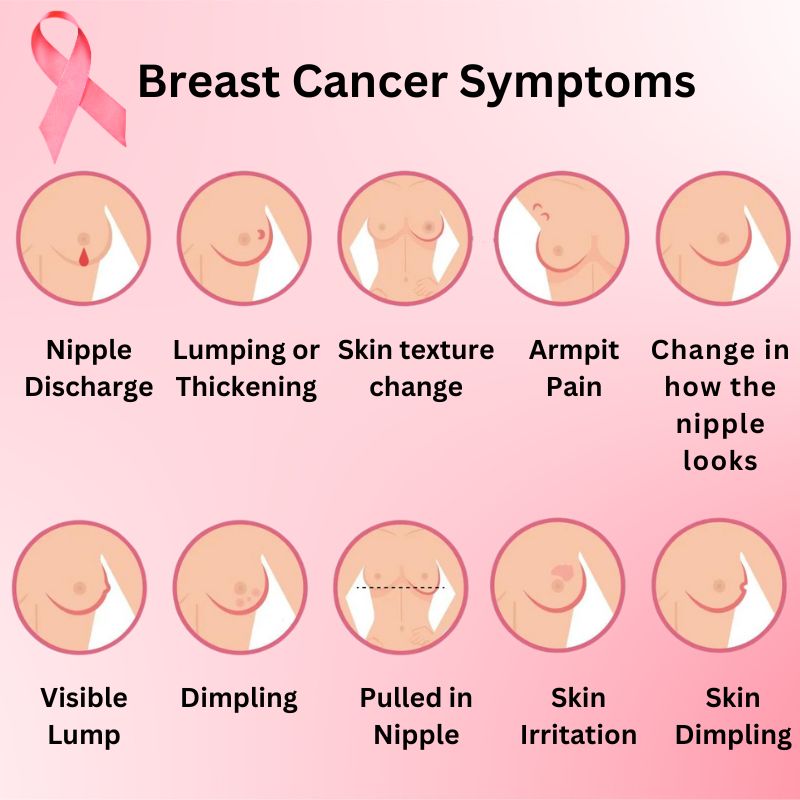October is "Breast Cancer Awareness Month" worldwide. Early diagnosis of breast cancer facilitates treatment. For a healthy life, routine doctor follow-ups, mammograms and self-breast checks should not be neglected.
What are the Symptoms of Breast Cancer?

Breast cancer can show different symptoms from person to person. Some people may even have no symptoms. In rare cases, men can also get breast cancer.
Some warning signs of breast cancer include:
- Redness on the breast skin,
- unusual pain in the breast,
- Liquid discharge from the nipple other than breast milk,
- A change in the appearance of your nipple (such as the nipple retracting),
- Wounds that develop on the nipple and do not go away for a long time, itchy, slightly bleeding dryness,
- The size difference between the two breasts and breast asymmetry that occurs later (Breast asymmetry that has existed for many years is generally not a scary situation for the patient. Breast asymmetries that develop subsequently raise suspicion of breast cancer.),
- A palpable lump under the breast tissue,
- The formation of palpable glands under the armpit is among the symptoms of breast cancer.
These symptoms can also occur in other non-cancerous conditions. However, if you notice these symptoms, you should consult a doctor immediately.
What Should Be Done for Early Diagnosis of Breast Cancer?
- General surgeon visits for breast examination every two years,
- Every woman, especially between the ages of 40-69, should perform breast self-examination at home every month.
- Every woman between the ages of 35 and 40 should have her first mammogram.
- Every woman between the ages of 40 and 50 should have a mammogram every two years.
- Every woman aged 50 and over should have a mammogram once a year.
- Individuals with a family history of breast cancer should have their first follow-up mammogram at the age of 30 and should have a mammogram every year thereafter.
How to Self-Check Breast Cancer at Home?
The same day of each month should be chosen for breast cancer self-examination.
Breast cancer self-examination is done as follows:
- For examination, you stand in front of a mirror.
- Both breasts should be visible in the mirror.
- First, the right hand is placed on the nape of the neck.
- The examination is performed by joining the index and middle fingers of the left hand and drawing small circles from the outermost part of the breast. Every part of the breast, from the outermost part to the nipple, is scanned. At this time, it should be pressed lightly and it should be determined whether there is a mass that can be felt under the skin.
- If there is any abnormality or collapse in the general appearance of the breast, it should be monitored by looking in the mirror at the same time as the examination.
- The same procedure should be applied to the left breast.
- After breast examination, the armpit should also be examined.
- If a mass is detected or deformity is observed, a doctor should be consulted.
When to Worry About Breast Pain?
Pain Related to the Menstrual Cycle
Chest pain is common during the menstrual cycle. It is not directly associated with breast cancer and tends to occur in both breast areas. It is felt in the outer and upper parts of the breast, near the armpit. However, if it is at a level that interferes with daily activities, it becomes a cause for concern.
Persistent Discomfort
If breast pain worsens over time and continues after the menstrual cycle ends, a doctor should be consulted.
Localized and Refractory Pain
Pain that is sharply focused and unresponsive to over-the-counter painkillers should be taken seriously.
Extended Duration
If breast pain persists for more than 15 days within a month, this should not be ignored and a healthcare professional should be consulted immediately.
Accompanying audiences
If chest pain coincides with the discovery of a palpable mass, a doctor should be consulted immediately.
Natural Breast Shape
When the breast shape remains unchanged and there are no unusual changes, this may be indicative of typical hormonal fluctuations.
No Nipple Retraction or Discharge
When there is no nipple retraction or discharge of milky substances, there are relatively fewer concerns about breast pain.
Where to Go for Suspicion of Breast Cancer?
An individual with suspicion of breast cancer should go to the general surgery department.
What is Oncoplastic Breast Surgery?
Filling the space created by the cancerous tissue removed for treatment of breast cancer with breast tissue and muscle tissue is called Oncoplastic Breast Surgery. In this way, an aesthetic breast appearance is achieved.
Is Oncoplastic Breast Surgery Applied to Everyone?
Unfortunately, this surgical procedure cannot be applied to every breast cancer patient. In order for Oncoplastic Breast Surgery to be performed, the patient's breast skin must not be damaged due to cancer.
To Which Patient Groups Is Breast Reconstruction (Repair) Performed?
All women diagnosed with breast cancer are candidates for breast reconstruction. However, in order to decide on breast reconstruction, I need to examine the patient, taking into account the information given by the oncologist. After this, if the patient is suitable for surgery, breast reconstruction can be performed.
What Does Mastectomy Surgery Mean?
Mastectomy is a surgery performed to remove cancerous tissue from the body in the treatment of breast cancer.
